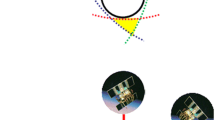Abstract
A limitation of GPS positioning is that the vertical component is generally two to three times less precise than the horizontal components. In a previous work by R. Santerre of Laval University and G. Beutler of University of Bern, it was shown in simulations that it is possible to improve the GPS vertical positioning precision by using a multi-antenna GPS receiver and a precise calibration technique of the relative hardware delay between the antennas and the receiver. However, no actual implementation of the system was done to prove the concept until now. A new multi-antenna, GPS-over-fiber architecture with real-time delay monitoring, designed and implemented to improve the vertical precision is presented. The improvement in vertical precision arises from the elimination of the relative receiver clock error in single difference, between antennas, and the precision real-time calibration of the relative hardware delay. Experiments were conducted with a zero baseline and a short baseline configuration. The results show, as expected by the theory and the simulations, a two to three times improvement in the precision of the vertical component such that it reached the same level of performance as the horizontal components. These promising results will enable the use of this type of configuration in several applications where the same precision in all 3D components is essential and could not be achieved before with standard GPS positioning techniques.











Similar content being viewed by others
References
Akrour B, Santerre R (1998) Utilisation optimale du système de positionnement GPS pour les travaux d’auscultation de barrages. Geomatica J de l’Association Canadienne des Sci Géomatiques 52(4):441–451
Dach R, Hugentobler U, Fridez P, Meindl M (eds) (2004) Bernese GPS software version 5.0. Astronomical Institute, University of Bern., Switzerland
Dennis T, Williams P (2005) Achieving high absolute accuracy for group-delay measurements using the modulation phase-shift technique. J Lightwave Technol 23(11):3748–3754
Fortin M-A, Landry R Jr (2009) Development of a universal GNSS tracking channel. In: Proceedings of the 22nd International Technical Meeting of the Satellite Division of the Institute of Navigation (ION GNSS 2009), pp 259–272. Savannah, GA, USA
Larson D, Paulter N Jr (2007) A measurement of propagation delay. Metrologia 44:64–69
Lindlohr W, Wells D (1985) GPS design using undifferenced carrier beat phase observations. Manuscripta Geodaetica 10:255–295
Macias-Valadez D (2011) Improvement of vertical precision in GPS positioning with a GPS-over-fiber configuration and real-time relative hardware delay monitoring, PhD Dissertation. Université Laval, Faculté de foresterie de géographie et de géomatique, Quebec, Canada
Macias-Valadez D, LaRochelle S, Santerre R, Filion B (2009a) Fiber optic synchronization architecture for high precision GPS applications. Conference on optical fiber communication OFC 2009, pp 1–3. San Diego, CA, USA
Macias-Valadez D, Santerre R, LaRochelle S, Landry R Jr (2009b) GPS-over-fiber architecture with relative cable delay monitoring for high precision GPS applications. In: Proceedings of the 22nd International Technical Meeting of the Satellite Division of the Institute of Navigation (ION GNSS 2009), pp 622–634. Savannah, GA, USA
Macias-Valadez D, Santerre R, LaRochelle S (2010). Method and system for high precision GPS applications, patent No. PCT/CA2010/000433 (Patent Pending). International Application
Rothacher M, Beutler G, Gurtner W, Geiger A, Kahle H, Schneider D (1986) The 1985 Swiss GPS campaign. In: Proceedings of the 4th international geodetic symposium on satellite positioning, pp 979–991. Austin, TX, USA
Santerre R (1991) Impact of GPS satellite sky distribution. Manuscripta Geodaetica 16(1):28–53
Santerre R, Beutler G (1993) A proposed GPS method with multi-antennae and single receiver. Bull Géodésique 67:210–223
Santerre R, Geiger A (1998) Geometrical interpretation of GPS positioning with single, double and triple difference carrier phase observations. In: Proceedings of the symposium on geodesy for geotechnical and structural engineering, IAG special commission IV, pp 465–470. Eisenstadt, Austria
Sauriol B, Landry R Jr (2007) FPGA-based architecture for high throughput, flexible and compact real-time GNSS software defined receiver. In: Proceedings of the 2007 National Technical Meeting of the Institute of Navigation, pp 708–717. San Diego, CA, USA
Souza E, Monico J (2004) Wavelet shrinkage: high frequency multipath reduction from GPS relative positioning. GPS Solut 8(3):152–159
Wild U, Beutler G, Gurtner W, Rothacher M (1989) Estimating the ionosphere using one or more dual frequency GPS receivers. In: Proceedings of the 5th international geodetic symposium on satellite positioning, pp 724–736. Las Cruces, CA, USA
Wübbena G, Schmitz M, Menge F, Böder V, Seeber G (2000) Automated absolute field calibration of GPS antennas in real-time. In: Proceedings of the Institute of Navigation ION GPS-2000, pp 2514–2522. Salt Lake City, UT, USA
Zhong P, Ding X, Yuan L, Xu Y, Kwok K, Chen Y (2009) Sidereal filtering based on single differences for mitigating GPS multipath effects on short baselines. J Geodesy 84:145–158
Acknowledgments
The research reported is a summary of the PhD research conducted by the main author under the supervision of the last three authors. The research has been carried out mainly under the financial support of the Natural Sciences and Engineering Research Council of Canada (NSERC). Financial support was also provided by the Faculty of Forestry, Geography and Geomatics of Laval University. The authors would like to thank all people who contributed, at different levels, to the realization of this project: Prof. Gerhard Beutler (University of Bern), Prof. Marc Cocard (Laval University) and Dr. Michel Poulain (TeraXion) for their valuable comments as members of the thesis examining committee; Bruno Sauriol, Marc-Antoine Fortin and Jean-Christophe Guay of the École de Technologie Supérieure (ÉTS) in Montreal for their work and help with the FPGA-based GPS receiver used in this research; Stéphanie Bourgon and Guy Montreuil for their support in the GPS processing software and field tests; Benoît Filion and Philippe Chrétien for their participation in the stage of designing and building the prototype of the GPS-over-fiber system.
Author information
Authors and Affiliations
Corresponding author
Rights and permissions
About this article
Cite this article
Macias-Valadez, D., Santerre, R., Larochelle, S. et al. Improving vertical GPS precision with a GPS-over-fiber architecture and real-time relative delay calibration. GPS Solut 16, 449–462 (2012). https://doi.org/10.1007/s10291-011-0244-6
Received:
Accepted:
Published:
Issue Date:
DOI: https://doi.org/10.1007/s10291-011-0244-6




